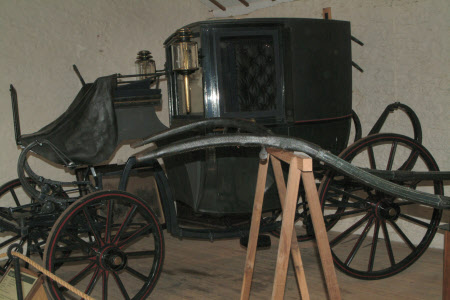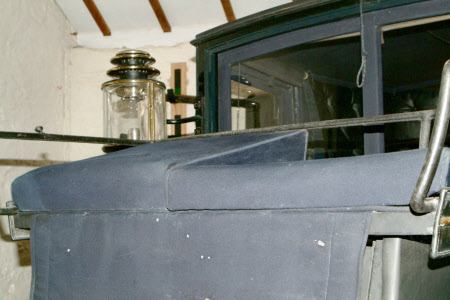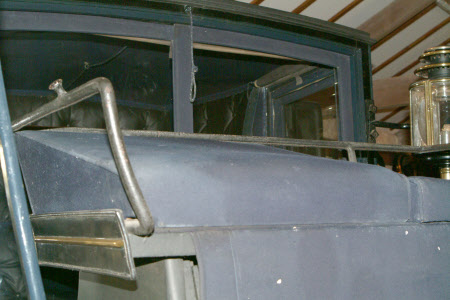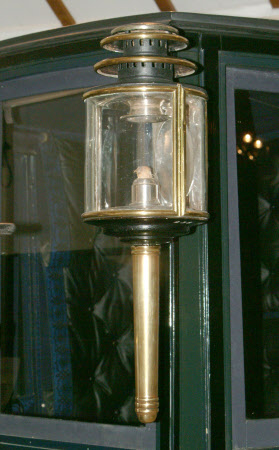Single brougham
Turrill and Sons
Category
Carriages & other vehicles
Date
1860 - 1880
Materials
Bone, Glass, Leather, Textile, Wood
Measurements
3400 x 1680 mm; 1980 mm (Length)9 cwt (Wt)
Place of origin
London
Order this imageCollection
National Trust Carriage Museum
NT 272873
Summary
Single Brougham built for the Marquess of Bute by Turrill and Sons between 1860 and 1880.
Full description
On an iron perch with C springs and under springs. Of angular profile with sunk footboard between moulded brackets. Single sear rails, hinged heel board. Pole through top rail for coachman’s communication cord. Leather covered roof and upper panels. Painted iron body hoops (back only). With storm apron and box seat. In dark green and livery with red lining and with Bute crest 'Avito vinet honore' (He flourishes by ancestral honours). The Brougham was named after Lord Brougham, who designed the prototype of this closed carriage in 1838. This example, built by Turrill & Sons, South Audley St., Grosvenor Square, London, was an ideal town carriage. A single Brougham seats two, and a double Brougham has an additional front seat and can carry four. In 1810 Obadiah Elliot registered a patent for his idea of mounting four-wheeled carriages on elliptic springs, instead of the large, heavy and expensive perch undercarriages previously used, and this new principle was adopted for all relatively small four-wheeled carriages. Though much cheaper and very practical, this new development was not as comfortable, and certainly not as stylish. In 1840 the first brougham was built that was mounted on a wrought iron perch with C springs and under springs which had the added advantage of showing that the owner could afford this much more expensive style and extra comfort. This is an example of this style. It was one of several carriages donated by the Marquis of Bute. It was probably built with no brake, and probably originally had a drag shoe, like the Marquis’s Victoria, and the brake was probably added later. It has some very attractive interior fittings including a bell to attract the coachman’s attention. There is also a cord that attaches to the coachman’s finger for the same purpose. BODY Of angular profile with sunk footboard between moulded brackets. Single sear rails, hinged heel board. Pole through top rail for coachman’s communication cord. Leather covered roof and upper panels. Painted iron body hoops (back only). Doors Doors on two concealed hinges with brass T handles and Landau locks. Steps Trapezoidal jagged plate steps at door with door mounted step covers. Rectangular jagged plate treads on outer roller bolts and rectangular jagged plate steps on extended bars for braces. Windows Lowering windows in doors. Sliding front windows. Frames covered with blue wool cloth. Panel blinds in doors. Rectangular back light. Lamps Cylindrical lamps with three tier round chimney on iron bolted to front pillars. External Furniture Brass CARRIAGE Wheels 12 and 14 spoke English pattern wheels with staggered spokes and bent half rims. Axles Collinges patent axles, front straight and hind cranked down adjacent to springs and compassed down. Springs C springs and under springs. Dumb irons with no capping. Fore carriage Open futchell fore carriage of angular design with compassed transom and axle bed, straight horn bar with angular pattern fiddle ends and full wheel plate. POLE AND SHAFTS Perch Wrought iron perch reflecting the lines of the wheel arech and the underside of the body. Hind carriage Straight axle bed and spring bed with fiddle ends to match fore carriage. Spiked bar on spring bed. Brake Lever action break with wood blocks, double curved handle, rack mounted on base offside front C spring and linkage exposed in wheel arch and beneath body. Paint Roof, upper panels, boot, underside of floor matt black. Body frame, back light frame gloss black. Panel blinds black in varnished mahogany frames. Lower body panels dark green. Wheels, under carriage, brackets and underside of footboard dark blue with broad red lines only on wheels and red pinbead at bottom of upper panels. Heraldry Bute coat of arms with two crests and Marquis coronet on fence rails and on back panel. Leather Leather main braces, collar braces, dashboard with leather served mounting handles, leather apron lined with dark brown cotton cloth. Welted coachman’s seat valance, leather served seat rails, leather serving on brackets, leather covered roof. Leather splash guards on doors. Stencilled floor cloth on front floor and footboard. External Trimming Coachman’s wedge driving box and footman’s parallel box covered in self-piped blue faced wool cloth. Seat fall similar. Roof lining and lining to front panel and parcel shelf blue faced wool cloth. Internal Trimming Seat back, back squab, ¼ squabs and door squabs black morocco with leather covered buttons (Seat cushions missing). Brussels carpet with light blue flowers on dark blue ground on sills, foot recess, heelboard and loose main carpet. Broad laces black worsted geometric figure on blue ribbed silk ground on double loop hand holders, glass strings, surrounds to door panels. Minor laces to match. Dark blue taffeta spring curtains at all windows. Coachman’s communication cord with silk tassel. Internal Furniture Drawer with front veneered in rosewood and containing three compartments lined with blue silk velvet, together with three leather lined open compartments attached by ivory rails at front. Spring hook for cane or umbrella. Bell in off side of boot with ivory pull knob beneath front window. Other internal furniture all in ivory.
Provenance
Owned by the Marquess of Bute family. In 1947 the 5th Marquess of Bute donated ten carriages to the National Museum Wales (then Welsh Folk Museum), without any conditions attached to the donation. In 1948, when the Welsh Folk Museum opened two of the carriages were put on display in their coach house, but they could not display the other carriages, which were put into storage. In January 1964 the 6th Marquis of Bute suggested that the carriages in store could be given to the National Trust to help establish the carriage collection at Arlington Court. As the carriages were in the ownership of the NMW they arranged for the unconditional transfer of 8 carriages to Arlington Court.
Makers and roles
Turrill and Sons, coach builder




